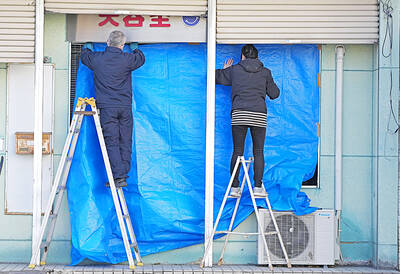A team at National Taiwan University Hospital (NTUH) has performed the world’s first heart transplant with zero ischemic time, using a new system that ensures the donor heart never skips a beat, reducing damage.
In traditional heart transplant surgeries, the heart stops beating after it is procured from a donor, and the period from its retrieval to implantation is referred to as the ischemic time, said Chi Nai-hsin (紀乃新), an attending physician at NTUH’s Cardiovascular Center.
“We wanted to perform a heart transplant without any ischemic time so that the heart wouldn’t have to stop, and we could also avoid injury [to heart tissue] that typically occurs after reperfusion,” Chi told a news conference at the hospital in Taipei yesterday.

Photo: Lin Chih-yi, Taipei Times
While the ischemic time for most heart transplants is typically kept under four hours, Chi said shorter durations mean less myocardial damage, higher transplant success rates and better function, as ischemia leads to oxygen deprivation in cardiac muscle cells.
To keep the heart beating and avoid ischemia during the transplant procedure, the NTUH team drew inspiration from extracorporeal membrane oxygenation and designed a mobile organ care system (OCS) that can continuously perfuse the heart with oxygenated blood, Chi said.
After receiving approval from NTUH’s Research Ethics Committee in April last year, a transplant surgery using the new OCS was performed in August on a 49-year-old female patient with dilated cardiomyopathy — a heart muscle disease that makes it harder to pump blood, Chi said.
In a video shown at the news conference, the donor heart was connected to the OCS and continued beating as it was transported to another operating room, where the female patient awaited the transplant.
After the successful transplant, the patient, surnamed Su (蘇), resumed normal daily life with a heart that never skipped a beat, and follow-up assessments showed excellent heart function, Chi said.
He cited her low level of cardiac enzyme — an indicator of heart muscle injury that is typically elevated after transplantation — as an example of the heart’s well-preserved condition following the surgery.
“We have demonstrated the safety and feasibility of the surgery,” Chi said.
Another heart transplant using the same OCS was successfully performed earlier this year, adding to hopes that the technique can be applied to more cases in the future, Chi said.
Su’s case and the use of the OCS were featured in an article titled “First-in-human Zero-Ischemia-Time Beating-Heart Transplant,” which was accepted for publication by the Journal of Thoracic and Cardiovascular Surgery Techniques, an international peer-reviewed journal, late last month.
In the same journal, a team of researchers from Stanford University in the US published an article in March 2023 titled “First Beating-Heart Transplant From a Donation after Cardiac Death Donor.”
According to the article’s “central message,” the Stanford researchers reported “the first case of a beating heart transplant with uninterrupted coronary perfusion in a heart procured from a deceased after circulatory death.”
Asked about the difference between NTUH’s procedure and Stanford’s, Chen Yih-shurng (陳益祥), head of NTUH’s organ transplant team, said that the Stanford team briefly stopped the donor heart after procurement before connecting it to the OCS, resulting in a short ischemic period of about 10 to 30 minutes.
For the two cases performed by NTUH’s team, “the hearts were still beating before procurement, continued beating after procurement, and never stopped — achieving zero ischemic time,” Chen said.

Taiwanese were praised for their composure after a video filmed by Taiwanese tourists capturing the moment a magnitude 7.5 earthquake struck Japan’s Aomori Prefecture went viral on social media. The video shows a hotel room shaking violently amid Monday’s quake, with objects falling to the ground. Two Taiwanese began filming with their mobile phones, while two others held the sides of a TV to prevent it from falling. When the shaking stopped, the pair calmly took down the TV and laid it flat on a tatami mat, the video shows. The video also captured the group talking about the safety of their companions bathing

US climber Alex Honnold is to attempt to scale Taipei 101 without a rope and harness in a live Netflix special on Jan. 24, the streaming platform announced on Wednesday. Accounting for the time difference, the two-hour broadcast of Honnold’s climb, called Skyscraper Live, is to air on Jan. 23 in the US, Netflix said in a statement. Honnold, 40, was the first person ever to free solo climb the 900m El Capitan rock formation in Yosemite National Park — a feat that was recorded and later made into the 2018 documentary film Free Solo. Netflix previewed Skyscraper Live in October, after videos

Starting on Jan. 1, YouBike riders must have insurance to use the service, and a six-month trial of NT$5 coupons under certain conditions would be implemented to balance bike shortages, a joint statement from transportation departments across Taipei, New Taipei City and Taoyuan announced yesterday. The rental bike system operator said that coupons would be offered to riders to rent bikes from full stations, for riders who take out an electric-assisted bike from a full station, and for riders who return a bike to an empty station. All riders with YouBike accounts are automatically eligible for the program, and each membership account

A classified Pentagon-produced, multiyear assessment — the Overmatch brief — highlighted unreported Chinese capabilities to destroy US military assets and identified US supply chain choke points, painting a disturbing picture of waning US military might, a New York Times editorial published on Monday said. US Secretary of Defense Pete Hegseth’s comments in November last year that “we lose every time” in Pentagon-conducted war games pitting the US against China further highlighted the uncertainty about the US’ capability to intervene in the event of a Chinese invasion of Taiwan. “It shows the Pentagon’s overreliance on expensive, vulnerable weapons as adversaries field cheap, technologically